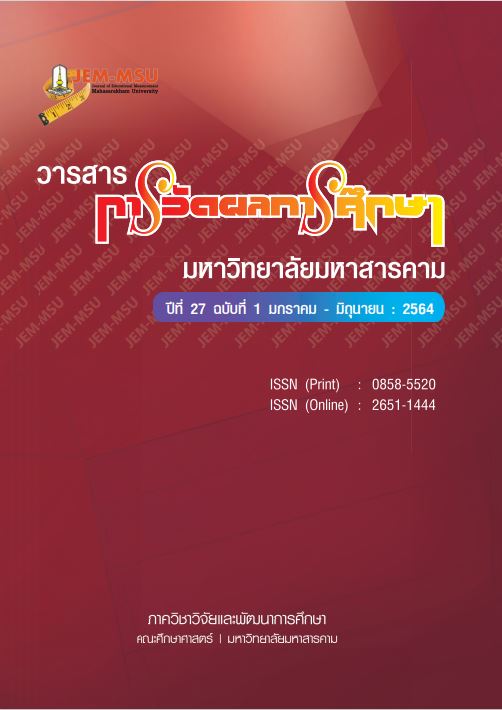Effects of Existential Group Counseling with Music on Sense of Coherence of Undergraduate Students
Main Article Content
Abstract
The purposes of this research were 1) to compare the effects of sense of coherence of undergraduate students between the experimental group and the control group in the post-experimental and follow-up stages, 2) to compare the effects of sense of coherence of undergraduate students in the experimental group in the pre-experimental, post-experimental and follow-up stages. The sample consisted of 14 undergraduate students of Khon Kaen University, Nongkhai Campus, aged between 18-22 years, who voluntarily participated in the research. The measure of sense of coherence, developed by Somporn Suthasanee (2002) was utilized. The scores from the moderate level down to the rather low ones were rearranged in ascending order, and then the Match-pair method was used to divide the sample into 2 groups, the experimental group and the control group, each group consisted of 7 people. The experimental group received 12 times of existential group counseling with music, twice a week, 60-90 minutes each time. The instruments used in this study was the sense of coherence test which was a 7-point rating scale, having the IOC from 0.50 to 1.00 and a reliability of 0.97, and counseling programs for the existential group with music. The statistics used for data analysis comprised the mean, standard deviation and repeated measures analysis of variance, one between subjects variable and one within subjects variable, and Bonferroni pair test at the statistical significance level of .05.
The research found that: 1) The sense of coherence of the experimental group in the post-experimental ( = 244.86, S.D. = 21.49) and the follow-up stages (
= 243.43, S.D. = 26.28) was higher than the control group in the post-experimental (
= 199.29, S.D. = 13.05) and the follow-up stages (
= 207.57, S.D. = 6.48) with statistical significance at the level of .05; and 2) The sense of coherence of the experimental group in the post-experimental (
= 244.86, S.D. = 21.49) and the follow-up stages (
= 243.43, S.D. = 26.28) was higher than the pre-experimental stage (
= 199.57, S.D. = 11.84) with statistical significance at the level of .05.
Article Details
The content and information contained in the published article in the Journal of Educational Measurement Mahasarakham University represent the opinions and responsibilities of the authors directly. The editorial board of the journal is not necessarily in agreement with or responsible for any of the content.
The articles, data, content, images, etc. that have been published in the Journal of Educational Measurement Mahasarakham University are copyrighted by the journal. If any individual or organization wishes to reproduce or perform any actions involving the entirety or any part of the content, they must obtain written permission from the Journal of Educational Measurement Mahasarakham University.
References
กรมสุขภาพจิต. (2562). ตีแผ่ปัญหาโรคซึมเศร้าในวัยรุ่น. [ออนไลน์]. ได้จาก https://dmh.go.th/news-dmh/view.asp?id=29585 [สืบค้นเมื่อ วันที่ 15 มีนาคม 2562].
กระทรวงสาธารณสุข. (2559). องค์ความรู้การดำเนินงานดูแลสุขภาพวัยรุ่นแบบบูรณาการสำหรับทีมนักจัดการสุขภาพวัยรุ่น (Teen Manager). นนทบุรี: บียอนด์.
กันยา สุวรรณแสง. (2554). จิตวิทยาทั่วไป (พิมพ์ครั้งที่ 6). กรุงเทพฯ: รวมสาส์น.
ณัชชา ตั้งตรงหฤทัย. (2559). การศึกษาบทบาทของเพลงร็อคในการปลูกฝังคุณค่าและการสร้างกำลังใจในการดำเนินชีวิตของเยาวชน. วารสารการสื่อสารและการจัดการนิด้า, 2(2), 33-34.
ทวีศักดิ์ สิริรัตน์เรขา. (2560). ดนตรีบําบัดพัฒนาชีวิต. [ออนไลน์]. ได้จาก https://www.happyhomeclinic.com [สืบค้นเมื่อ วันที่ 20 มิถุนายน 2561].
บุญชม ศรีสะอาด. (2556). การวิจัยเบื้องต้น. พิมพ์ครั้งที่ 9. กรุงเทพฯ: สุวีริยาสาส์น.
มหาวิทยาลัยสุโขทัยธรรมาธิราช. (2554). การปรึกษาเชิงจิตวิทยา. นนทบุรี: คณะศึกษาศาสตร์ มหาวิทยาลัยสุโขทัยธรรมาธิราช.
วัชรี ทรัพย์มี. (2556). ทฤษฎีให้บริการปรึกษา. กรุงเทพฯ : โรงพิมพ์จุฬาลงกรณ์มหาวิทยาลัย.
วัลลภา เทพหัสดิน ณ อยุธยา. (2556). อาจารย์ที่ปรึกษากัลยาณมิตร. กรุงเทพฯ: มหาวิทยาลัยธุรกิจบัณฑิตย์.
ศรีเรือน แก้วกังวาล. (2554). ทฤษฎีจิตวิทยาบุคลิกภาพ รู้เรา รู้เขา. กรุงเทพฯ: สำนักพิมพ์หมอชาวบ้าน.
สมพร สุทัศนีย์. (2545). การพัฒนาแบบทดสอบความสอดคล้องในการมองโลก สำหรับวัยรุ่นในจังหวัดชลบุรี. ภาควิชาการแนะแนวและจิตวิทยาการศึกษา, คณะศึกษาศาสตร์, มหาวิทยาลัยบูรพา.
Antonovsky. (1996). The salutogenic model as a theory to guide health promotion. Health Promotion International. 11(1), 11–18. Doi: 10.1093/heapro/11.1.11
Binkley, E. E. & Parmanand, S.P. (2010). Members’ experience of using music in a small group setting: A phenomenological study. Retrieved from: https://www.counseling.org/resources/library/VISTAS/2010-V-Online/Article_57.pdf
Chu, J.J., Khan, M.H., Jahn, H.J. & Kraemer, A. (2016). Sense of coherence and associated factors among university students in China: cross-sectional evidence. BMC Public Health, 16, 336. doi: 10.1186/s12889-016-3003-3
Correy, G. (2012). Theory and Practice of Group Counseling (8th ed.). United States of America: Brooks.
Gladding, S. T. (1992). Counseling as an Art: The creative arts in counseling. Alexandria, VA: American Association for Counseling and Development. Retrieved from https://eric.ed.gov/?id=ED340984
Gladding, S. T., Newsome, D., Binkley, E., & Henderson, D. (2008). The lyrics of hurting and healing: Finding words that are revealing. Journal of Creativity in Mental Health, 3(3), 212-219. doi: 10.1080/15401380802385210
Howell, D.C. (2010). Statistic methods for psychology. 7th ed. Belmont, CA: Wadsworth.
Lane, T. M. (2017). Integrating music activities into a school counselor's grief group with youth. Masters of Education, Counseling, University of Alaska Fairbanks.
Mittelmark, M.B., Sagy S., Eriksson, M., Bauer, G.F., Pelikan, J.M., Lindstrom, B., …Espnes, G.A. (Eds.). (2017). The handbook of Salutogenesis. Retrieved from:https://link.springer.com/content/pdf/10.1007%2F978-3-319-04600-6.pdf
Moksnes, U. k., Espnes, G. A. & Haugan, G. (2013). Stress, sense of coherence, and emotional symptoms in adolescents. Psychology & Health. DOI: 0.1080/08870446.2013.822868
Moreno, J. J. (1995). Ethnomusic therapy: An interdisiplinary approach to music and healing. The Arts in Psychology, 22(4), 329-338.
Rice, V. H. (2012). Handbook of stress, coping, and health: implications for nursing research, theory, and practice. 2nd ed. Thousand Oaks: SAGE Publications.
Situmorang, D. D. B. (2018). How amazing music therapy in counseling for millennials. Couns-Edu: International Journal of Counseling and Education, 3(2), 73-80. DOI: 10.23916/0020180313220
Winer, B.J., Brown, D.R., & Michels. K.M. (1991). Statistical principles in experimental design.3rd ed. New York: McGraw-Hill.


